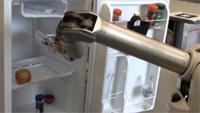Robotics

Yun Jiang, Marcus Lim, Changxi Zheng, and Ashutosh Saxena
Learning to Place New Objects in a Scene.
International Journal of Robotics Research (IJRR), 2012
Paper (PDF) Project Page Abstract Bibtex
Learning to Place New Objects in a Scene.
International Journal of Robotics Research (IJRR), 2012
Paper (PDF) Project Page Abstract Bibtex
Placing is a necessary skill for a personal robot to have in order to perform tasks such as arranging objects in a disorganized room. The object placements should not only be stable but also be in their semantically preferred placing areas and orientations. This is challenging because an environment can have a large variety of objects and placing areas that may not have been seen by the robot before.
In this paper, we propose a learning approach for placing multiple objects in different placing areas in a scene. Given point-clouds of the objects and the scene, we design appropriate features and use a graphical model to encode various properties, such as the stacking of objects, stability, object-area relationship and common placing constraints. The inference in our model is an integer linear program, which we solve efficiently via an LP relaxation. We extensively evaluate our approach on 98 objects from 16 categories being placed into 40 areas. Our robotic experiments show a success rate of 98% in placing known objects and 82% in placing new objects stably. We use our method on our robots for performing tasks such as loading several dish-racks, a bookshelf and a fridge with multiple items.
In this paper, we propose a learning approach for placing multiple objects in different placing areas in a scene. Given point-clouds of the objects and the scene, we design appropriate features and use a graphical model to encode various properties, such as the stacking of objects, stability, object-area relationship and common placing constraints. The inference in our model is an integer linear program, which we solve efficiently via an LP relaxation. We extensively evaluate our approach on 98 objects from 16 categories being placed into 40 areas. Our robotic experiments show a success rate of 98% in placing known objects and 82% in placing new objects stably. We use our method on our robots for performing tasks such as loading several dish-racks, a bookshelf and a fridge with multiple items.
@article{jiang2012placingobjects,
title={Learning to Place New Objects in a Scene},
author={Yun Jiang and Marcus Lim and Changxi Zheng and Ashutosh Saxena},
year={2012},
volume={31},
number={9},
journal={IJRR}
}
Yun Jiang, Changxi Zheng, Marcus Lim, Ashutosh Saxena
Learning to Place New Objects.
In International Conference on Robotics and Automation (ICRA), 2012. First appeared in RSS workshop on mobile manipulation, June 2011
Paper (PDF) Project Page Abstract Bibtex
Learning to Place New Objects.
In International Conference on Robotics and Automation (ICRA), 2012. First appeared in RSS workshop on mobile manipulation, June 2011
Paper (PDF) Project Page Abstract Bibtex
The ability to place objects in an environment is an important skill for a personal robot. An object should not only be placed stably, but should also be placed in its preferred location/orientation. For instance, a plate is preferred to be inserted vertically into the slot of a dish-rack as compared to be placed horizontally in it. Unstructured environments such as homes have a large variety of object types as well as of placing areas. Therefore our algorithms should be able to handle placing new object types and new placing areas. These reasons make placing a challenging manipulation task.
In this work, we propose a supervised learning algorithm for finding good placements given the point-clouds of the object and the placing area. It learns to combine the features that capture support, stability and preferred placements using a shared sparsity structure in the parameters. Even when neither the object nor the placing area is seen previously in the training set, our algorithm predicts good placements. In extensive experiments, our method enables the robot to stably place several new objects in several new placing areas with 98% success-rate; and it placed the objects in their preferred placements in 92% of the cases.
In this work, we propose a supervised learning algorithm for finding good placements given the point-clouds of the object and the placing area. It learns to combine the features that capture support, stability and preferred placements using a shared sparsity structure in the parameters. Even when neither the object nor the placing area is seen previously in the training set, our algorithm predicts good placements. In extensive experiments, our method enables the robot to stably place several new objects in several new placing areas with 98% success-rate; and it placed the objects in their preferred placements in 92% of the cases.
@inproceedings{jiang2012learningtoplace,
title={Learning to place new objects},
author={Jiang, Y. and Zheng, C. and Lim, M. and Saxena, A.},
booktitle={International Conference on Robotics and Automation (ICRA)},
year={2012},
} Loading ......
COPYRIGHT 2012-2018. ALL RIGHTS RESERVED.
